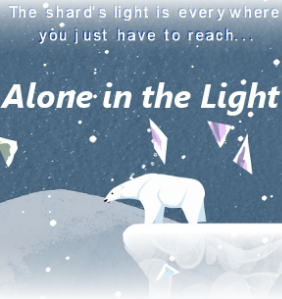By Joel Smart (The Cascade) – Email
Print Edition: November 21, 2012
The whistling wind rushes across the snowy ice of the arctic. An unusual beginning to a game, but so too is the main character – an ancient polar bear that saunters across the snow and dives into the deep blackness of the sea. Alone in the Light is not the game you’d expect from a FarmVille game designer, but Chelsea Howe is not so easily characterized when it comes to making games.
“This is a dream you had about being alone when the world was falling apart.” Suddenly the northern lights forget who they are, freeze and fall to the earth in broken shards. Nameless and completely alone in the world, you begin to wander in search of the shards. Soon it becomes apparent that the best way to find them is to howl into the wind. “You sing into a void and broken lights echo back,” the game hints. Sure enough, back comes a ringing note to alert you the direction and distance of the nearest shard. As you collect each piece it flutters into the air, circles around and follows you as you continue to hunt. “You saw them fall. Three shards for every note. Seven notes in all,” you are informed.
The idea came to Howe in a dream. “In the dream I was actually a seal, swimming in artic water black as a void. I couldn’t go on land – but that restriction made the water feel safe, like home,” she explained on her website. That’s when the northern lights came into play. “I found specks of the Aurora Borealis that had fallen from the sky and called out to them to wake up, wake up! When they were glowing again, I shepherded them together, guiding them through the waters.” For Howe, the experience was powerful and her game design instincts took hold. “I woke up with a vivid emotional imprint, and a head start on the mechanics,” she noted.
Building on the ideas, she began “Project Aurora.” Her focus was on evoking the emotions she felt: curiosity and wonder, but also solace and smallness. It was to be a touch-driven game designed for the iPad, and she began a partnership with a friend, Kim Koscamp, who volunteered to concept and create the art for her, despite having never done work on a game before.
They worked and worked and things progressed; but not everything always goes as planned. Howe realized the game was never going to make it onto the platform she had envisioned. She took it hard, not just because she felt she had failed, but because she felt she’d failed Koscamp who’d put her all into the project.
She couldn’t let it all just die. So in her spare time, she kept working on it. Not the original, touch-screen version, but a free version that could be played online. She found someone to help her convert the game to Flash, and slowly Project Aurora became Alone in the Light. On September 8, she finally released the game, along with a note to Kim, to whom she dedicated the game. “Kim, this is for you! Failing might phase you, but it never stops you. You hit walls and find ways to leap over, dig under, or just barrel right through them . . . You put your heart and soul into this project, and I hope at least some of that’s honoured with this version.”
It’s a game that plays like a love letter – to her friend and to her original concept that began with a powerful dream. It’s inventive and special and hopefully a sign of things to come from Howe and from other designers who create from their hearts. It’s not a difficult game, and it isn’t a long one, but from its depths, Alone in the Light emanates its simple beauty. It is poetry.
Alone in the Light can be played on its official website.


